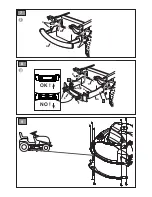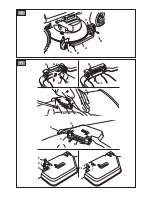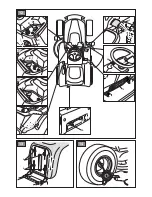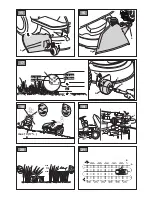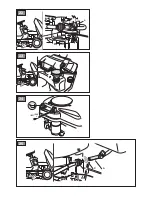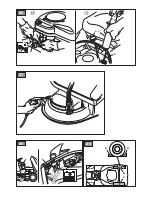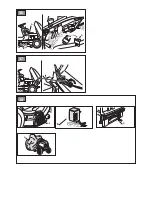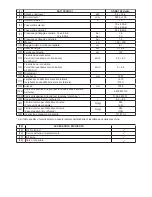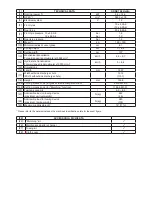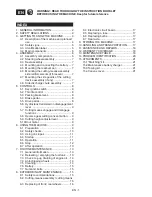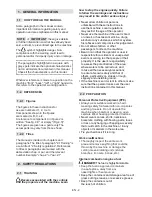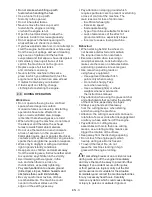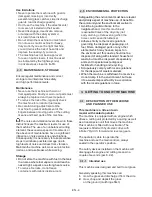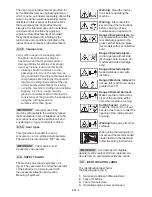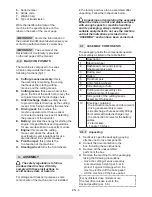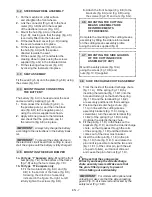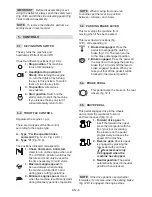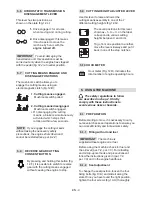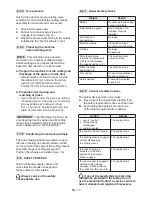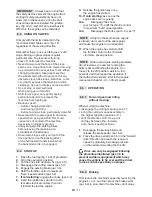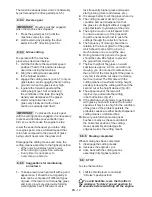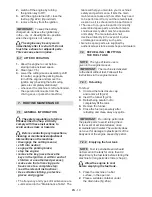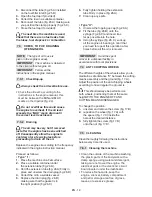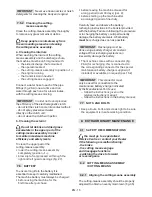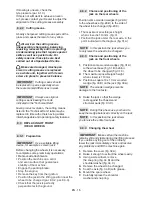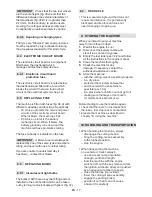
EN - 3
•
Do not smoke when filling up with
fuel or when handling the fuel.
• Use a funnel to top up with
fuel only in the open air.
• Do not inhale fuel fumes.
• Never remove the tank cap or add
fuel while the engine is running
or when the engine is hot.
• Open the fuel tank slowly to allow the
pressure inside to decrease gradually.
• Do not approach the tank opening with
a naked flame to check its contents.
• If you have spilled some fuel, do not attempt to
start the engine but move the machine away
from the area of spillage and avoid creating
any source of ignition until the fuel has
evaporated and fuel vapours have dissipated.
• Immediately clean up all traces of fuel
spilt on the machine or on the ground.
• Replace caps of all fuel tanks
and containers securely.
• Never start the machine in the same
place in which you refilled it with fuel; the
engine must be started in an area at least
3 metres from where you refuelled.
• If fuel is spilt on clothing, change
clothing before starting the engine.
2.3 DURING OPERATION
Work Area
•
Do not operate the engine in a confined
space where dangerous carbon
monoxide fumes can develop. All starting
operations have to be effected in an
open or well ventilated area. Always
remember that exhaust gases are toxic!
• When starting up the machine, do not direct
the silencer and therefore the exhaust
fumes towards flammable materials
.
• Do not use the machine in environments
at risk of explosion, in the presence of
flammable liquids, gas or powder. Electrical
contacts and mechanical friction can generate
sparks that can ignite the powder or vapours.
•
Work only in daylight or with good artificial
light in good visibility conditions.
• Keep persons, children and animals away
from the working area. Instruct another adult
to supervise any children in the vicinity.
• Avoid working with wet grass, in the
rain and when there is a risk of a
thunderstorm, especially lightening.
• Pay careful attention to uneven ground
(hills, dips), slopes, hidden hazards and
obstacles than could limit visibility.
• Be very careful near ravines, ditches
or embankments. The machine could
overturn if a wheel slides over the
edge or if the earth gives way.
• Pay attention on sloping ground which
requires particular care to prevent overturning
or loss of control of the machine. The
main reasons for loss of control are:
–
Insufficient wheel grip
– Excessive speed
–
Inadequate braking
– Type of machine unsuitable for its task
–
Lack of awareness of the effect of
ground conditions, especially slopes
– Incorrect use as a towing machine.
Behaviour
• When working behind the wheel, do
not become distracted and maintain
the required level of concentration.
• Exercise caution when reversing or
moving backwards. Look behind you to
make sure there are no obstacles before
and during operations in reverse gear.
• Use care when pulling loads or
using heavy equipment:
– Use approved drawbar hitch
points only when towing;
– Do not turn sharply. Take
care when reversing;
– Use counterweight(s) or wheel
weights whenever advised in
the instructions manual.
• Pay attention when using the grass catcher
and attachments that can alter the stability
of the machine, especially on slopes.
• Always keep hands and feet away
from the cutting means, when starting
and when using the machine.
•
Attention: the cutting means will continue to
rotate for a few seconds after disengagement
or after you have switched off the engine.
• Pay attention to cutting-means
assemblies with more than one cutting
means, as a rotating cutting means can
trigger the rotation of the others,
• Keep away from the discharge opening.
• Do not touch the engine parts which
heat up during use. Burns hazard.
•
To avoid the risk of fire, do not
leave the machine standing in high
grass with the engine running.
If something breaks or an accident occurs
during work, turn off the engine immediately
and move the machine away to prevent further
damage; if an accident occurs with injuries
or third parties are injured, carry out the first
aid measures most suitable for the situation
immediately and contact the medical authorities
for any necessary health care. Carefully
remove any debris which could cause damage
or injury to persons or animals if ignored.
Summary of Contents for SDNSL 108 Hydro
Page 2: ......
Page 3: ...ITALIANO Istruzioni Originali IT ENGLISH Translation of the original instruction EN ...
Page 5: ...5 3 A B C D E A F G H A A B C 4 B C C A 6 A B C D E ...
Page 6: ...7 I II A C C B OK NO A B C D D E F F G G 8 9 ...
Page 7: ...10 A B B C C 11 B 2 A C B 2 A D C B D 1 E D E 1 A B B 1 B B ...
Page 8: ...12 J A B C D E E 1 F G H I L E F II I 13 14 A A ...
Page 9: ...15 A B 16 B A 17 A H H 30 mm H 10 mm H 20 mm H 0 mm A C B D 18 max 10 17 19 A 20 1 3 21 A B ...
Page 10: ...22 A 23 24 25 B C A ...
Page 11: ...27 A B C A B C A 26 I II A A 28 29 A A B C ...
Page 12: ...A 110 mm 30 31 32 33 B A C C 34 A D B C 35 A B A A B C ...
Page 13: ...36 A A 37 38 B C D A2 ...
Page 38: ...STIGA S p A Via del Lavoro 6 31033 Castelfranco Veneto TV ITALY Type s n Art N stiga com ...



